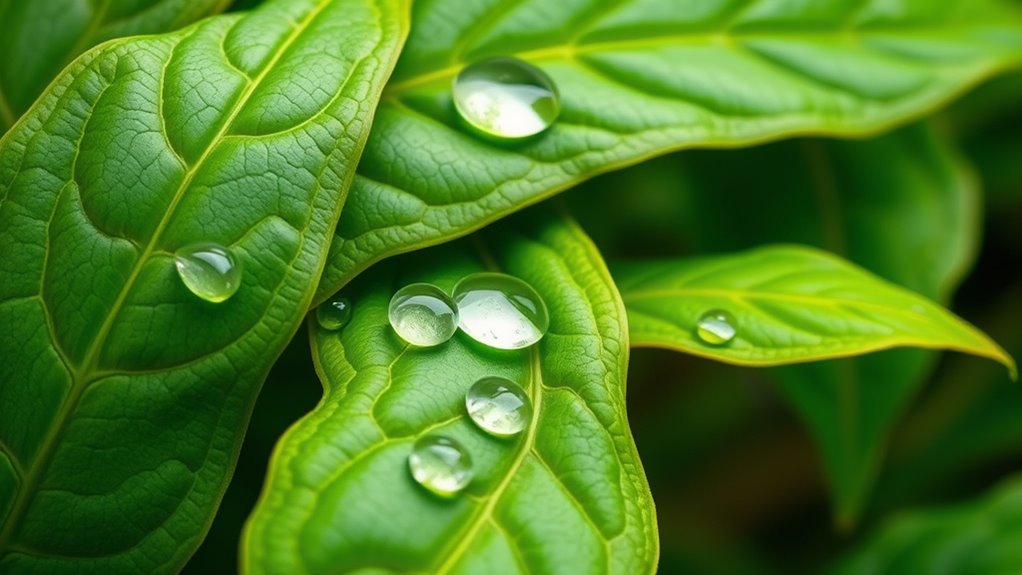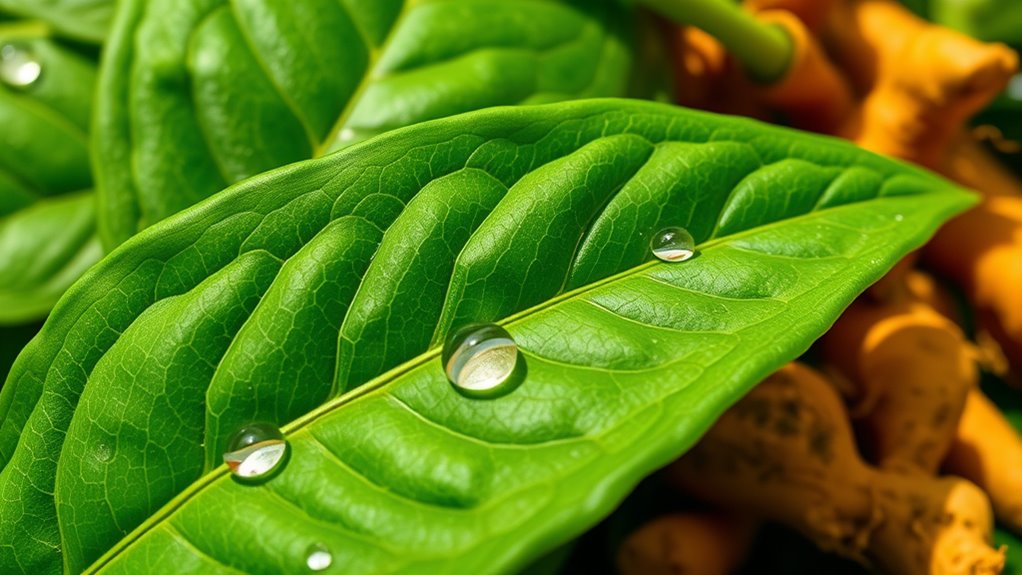Turmeric leaves have powerful anti-inflammatory effects, backed by centuries of traditional healing and scientific studies. They contain bioactive compounds like curcuminoids, essential oils, flavonoids, and phenolic acids that help reduce swelling and pain. People have used these leaves in teas, poultices, and topical applications to ease inflammation naturally. Their rich chemical makeup enhances their potency, making them a potent remedy. If you want to uncover more about their health benefits, keep exploring their incredible properties.
Key Takeaways
- Turmeric leaves contain curcuminoids and essential oils with potent anti-inflammatory and antioxidant properties.
- Traditional uses include topical applications and herbal teas to reduce inflammation and pain.
- Scientific studies support their ability to modulate inflammatory pathways similar to turmeric rhizomes.
- Chemical compounds in the leaves help scavenge free radicals and decrease oxidative stress.
- Their natural potency makes turmeric leaves a valuable, holistic remedy for inflammatory conditions.

Turmeric leaves have gained recognition for their potent anti-inflammatory properties, offering a natural remedy for reducing swelling and discomfort. Throughout history, traditional uses of turmeric leaves have spanned various cultures, especially in Southeast Asia. People have long used fresh or dried leaves in herbal remedies to soothe joint pain, skin inflammations, and digestive issues. They often prepare decoctions or infusions, believing these natural treatments help alleviate chronic inflammation and promote overall wellness. This rich history underscores the leaves’ significance beyond their culinary uses, highlighting their role as a natural medicine passed down through generations.
When you look into the chemical composition of turmeric leaves, you’ll find they contain a complex mix of bioactive compounds that contribute to their anti-inflammatory effects. These include essential oils, curcuminoids, flavonoids, and phenolic acids. Curcuminoids, similar to those found in turmeric rhizomes, are known for their powerful anti-inflammatory and antioxidant qualities. The essential oils, which release aromatic compounds, have been shown to possess antimicrobial and anti-inflammatory properties as well. Flavonoids and phenolic acids add further benefits by scavenging free radicals, reducing oxidative stress that often accompanies inflammation. This rich chemical makeup makes turmeric leaves particularly effective at targeting inflammation at its source, helping to reduce swelling and pain.
Additionally, recent studies suggest that the presence of high levels of curcuminoids in turmeric leaves enhances their ability to modulate inflammatory pathways, making them a promising natural remedy. You might be surprised to learn that the traditional uses of turmeric leaves align closely with what scientific studies now support. For centuries, herbalists and healers have relied on these leaves to treat various inflammatory conditions, often applying them topically or consuming them as part of herbal teas. These practices are rooted in a deep understanding of the leaves’ natural properties, even before modern science identified specific compounds responsible for their effects. Today, research confirms that the chemical composition of turmeric leaves provides the foundation for their anti-inflammatory power, validating their role in traditional medicine.
Incorporating turmeric leaves into your health regimen can be as simple as brewing a tea or preparing a poultice. Knowing their traditional uses and chemical composition helps you appreciate their natural potency and safety. As more studies explore the full range of their bioactive compounds, you’re likely to discover even more benefits from these versatile leaves. Whether used in ancient remedies or modern herbal practices, turmeric leaves remain a potent, natural solution for inflammation. Their rich history, combined with scientific backing, makes them a valuable addition to your holistic health toolkit.
Frequently Asked Questions
Can Turmeric Leaves Be Used in Cooking Like Turmeric Root?
You might wonder if turmeric leaves can be used in cooking like turmeric root. While turmeric leaves are not typically used as a primary ingredient in cooking applications, they do have culinary uses. You can add fresh leaves to broths, teas, or wraps for flavor and aroma. However, their flavor is subtler than the root, so use them in dishes where their aroma can shine without overpowering other ingredients.
Are There Any Side Effects From Consuming Turmeric Leaves?
You might wonder if eating turmeric leaves causes side effects. While generally safe, some people could experience allergic reactions like skin rashes or itching. Digestive issues, such as stomach upset or nausea, may also occur if you consume them in large amounts. It’s best to start with small quantities to see how your body reacts, and consult a healthcare professional if you notice any adverse effects.
How Do Turmeric Leaves Compare to Turmeric Powder in Anti-Inflammatory Effects?
Think of turmeric leaves and powder as siblings competing in a race. You’ll find that turmeric leaves often have a comparative potency in anti-inflammatory effects, thanks to their unique compounds. Extraction methods play a key role, as gentle, whole-plant extraction preserves more of these beneficial properties in leaves. While powder is convenient, fresh leaves may offer a stronger, more natural anti-inflammatory boost, making them a valuable alternative.
Can Turmeric Leaves Help With Chronic Inflammatory Conditions?
You might find turmeric leaves helpful for chronic inflammatory conditions, as traditional medicine often uses them to reduce inflammation. Their natural anti-inflammatory compounds support herbal detox efforts, potentially easing symptoms over time. While more research is needed, incorporating turmeric leaves into your routine could complement your health plan, offering a plant-based approach to managing long-term inflammation naturally. Always consult a healthcare professional before making significant changes.
Are Turmeric Leaves Safe for Children or Pregnant Women?
When considering turmeric leaves, child safety and pregnancy considerations are important. You should consult a healthcare professional before giving turmeric leaves to children or using them during pregnancy, as safety isn’t fully confirmed. While they may offer health benefits, potential risks or interactions could affect your child or pregnancy. Always prioritize professional advice to ensure safe use, especially for vulnerable populations like children and pregnant women.
Conclusion
So, next time you’re reaching for those pricey supplements, remember the humble turmeric leaves might be hiding your new best friend. Who knew that something so simple could pack such a punch against inflammation? It’s almost ironic—nature’s own remedy quietly waiting in your backyard while we chase after synthetic cures. Sometimes, the best solutions are right under your nose, or in this case, right in your garden. Who knew turmeric leaves had such surprising power?









